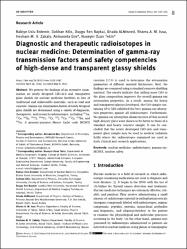Diagnostic and therapeutic radioisotopes in nuclear medicine: Determination of gamma-ray transmission factors and safety competencies of high-dense and transparent glassy shields

View/
Date
2022Author
Erdemir, Rabiye UsluKılıç, Gökhan
Şen Baykal, Duygu
ALMisned, Ghada
Issa, S.A.M.
Zakaly, H.M.H.
Ene, A.
Tekin, H.O.
Metadata
Show full item recordCitation
Erdemir, R. U., Kılıç, G., Şen Baykal, D., ALMisned, G., Issa, S.A.M., Zakaly, H.M.H., Ene, A., Tekin, H.O. (2022). Diagnostic and therapeutic radioisotopes in nuclear medicine: Determination of gamma-ray transmission factors and safety competencies of high-dense and transparent glassy shields. Open Chemistry. ss. 517-524. De Gruyter.Abstract
Abstract
We present the findings of an extensive examination on newly designed CdO-rich and transparent glass shields for nuclear medicine facilities in lieu of traditional and unfavorable materials, such as lead and concrete. Gamma-ray transmission factors of newly designed glass shields are determined using a variety of diagnostic, therapeutic, and research radioisotopes, including 67Ga, 57Co, 111In, 201Tl, 99mTc, 51Cr, 131I, 58Co, 137Cs, 133Ba, and 60Co. A general-purpose Monte Carlo code MCNPX (version 2.7.0) is used to determine the attenuation parameters of different material thicknesses. Next, the findings are compared using a standard concrete shielding material. The results indicate that adding more CdO to the glass composition improves the overall gamma-ray attenuation properties. As a result, among the heavy and transparent glasses developed, the C40 sample containing 40% CdO exhibited the best gamma-ray absorption properties against all radioisotopes. Furthermore, the gamma-ray absorption characteristics of this created high-density glass were shown to be better to those of a standard and heavy concrete sample. It can be concluded that the newly developed CdO-rich and transparent glass sample may be used in medical radiation fields where the radioisotopes examined are used in daily clinical and research applications.

















